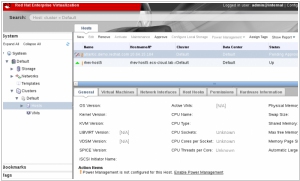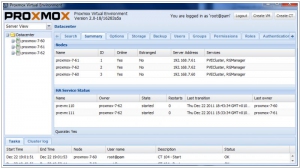Proxmox vs Red Hat Virtualization
July 25, 2023 | Author: Michael Stromann
7

Red Hat Virtualization is an open, software-defined platform that virtualizes Linux and Microsoft Windows workloads. Built on Red Hat Enterprise Linux and the Kernel-based Virtual Machine (KVM), it features management tools that virtualize resources, processes, and applications—giving you a stable foundation for a cloud-native and containerized future.
Proxmox and Red Hat Virtualization are both powerful virtualization platforms, but they have key differences in terms of their focus, architecture, and support. Proxmox Virtual Environment (Proxmox VE) is an open-source solution that combines virtualization and containerization in a single platform. It is built on Debian and utilizes Kernel-based Virtual Machine (KVM) for virtualization and LXC containers for lightweight virtualization. Proxmox VE is known for its simplicity, ease of use, and robust feature set, making it a popular choice for small to medium-sized businesses and enthusiasts. Its open-source nature allows for flexibility and customization, but official support options are available through subscription plans.
On the other hand, Red Hat Virtualization (RHV) is a commercially-supported virtualization platform built on top of Red Hat Enterprise Linux (RHEL). RHV uses the Kernel-based Virtual Machine (KVM) hypervisor and provides advanced virtualization management capabilities through the Red Hat Virtualization Manager. It targets enterprise-level deployments and emphasizes scalability, performance, and high availability. Red Hat Virtualization offers a comprehensive ecosystem and integration with other Red Hat products, making it suitable for large organizations seeking enterprise-level support and robust management features.
One of the major distinctions between Proxmox and Red Hat Virtualization is the licensing and support model. Proxmox VE is open-source and offers a free version with community support, while enterprise-grade support is available through a paid subscription. In contrast, Red Hat Virtualization is a commercial product that requires a subscription for access to support, updates, and maintenance. The choice between Proxmox and Red Hat Virtualization depends on the specific needs and resources of the organization or user. Proxmox VE appeals to those seeking a cost-effective and feature-rich virtualization solution with open-source flexibility, while Red Hat Virtualization caters to larger enterprises that value comprehensive support, integration, and performance for critical workloads.
See also: Top 10 Virtualization platforms
On the other hand, Red Hat Virtualization (RHV) is a commercially-supported virtualization platform built on top of Red Hat Enterprise Linux (RHEL). RHV uses the Kernel-based Virtual Machine (KVM) hypervisor and provides advanced virtualization management capabilities through the Red Hat Virtualization Manager. It targets enterprise-level deployments and emphasizes scalability, performance, and high availability. Red Hat Virtualization offers a comprehensive ecosystem and integration with other Red Hat products, making it suitable for large organizations seeking enterprise-level support and robust management features.
One of the major distinctions between Proxmox and Red Hat Virtualization is the licensing and support model. Proxmox VE is open-source and offers a free version with community support, while enterprise-grade support is available through a paid subscription. In contrast, Red Hat Virtualization is a commercial product that requires a subscription for access to support, updates, and maintenance. The choice between Proxmox and Red Hat Virtualization depends on the specific needs and resources of the organization or user. Proxmox VE appeals to those seeking a cost-effective and feature-rich virtualization solution with open-source flexibility, while Red Hat Virtualization caters to larger enterprises that value comprehensive support, integration, and performance for critical workloads.
See also: Top 10 Virtualization platforms




